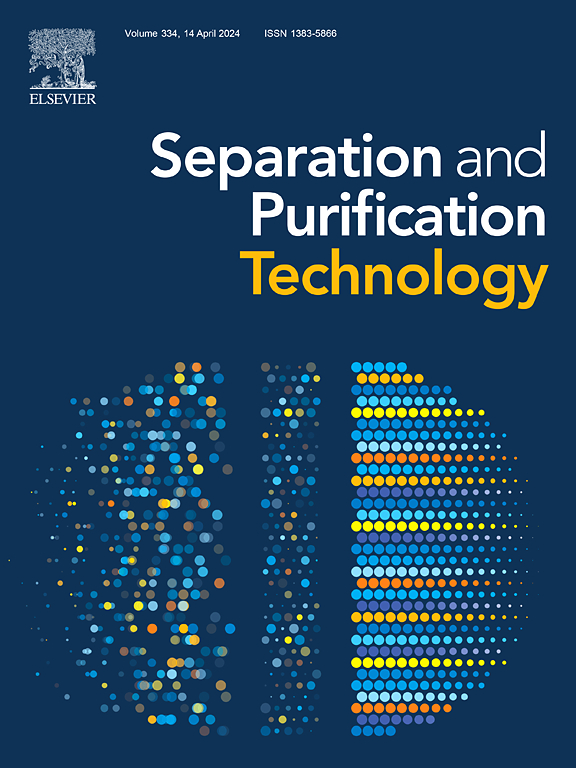Efficient degradation of ofloxacin using O3/Mn-Ce/γ-Al2O3/PMS process: Efficiency, synergy and mechanism
IF 9
1区 工程技术
Q1 ENGINEERING, CHEMICAL
引用次数: 0
Abstract
This work developed a novel ozone (O3)/Mn-Ce/γ-Al2O3(MC)/peroxymonosulfate (PMS) process for the degradation of ofloxacin (OFX) in wastewater. The combination of O3, MC, and PMS exhibited a significant synergistic effect, achieving 95.17 % degradation and 76.05 % TOC removal in 50 min, which were markedly higher than those of the O3/PMS, MC/PMS, and O3/MC processes. OFX was effectively mineralized (> 66.35 %) across a wide pH range (3.0–11.0), with minimal inhibition from common anions (CO32–, NO3–, Cl–). Additionally, the O3/MC/PMS process maintained stable performance in continuous real pharmaceutical wastewater treatment with over 60 % TOC removal and low metal leaching (< 20 μg L-1), confirming strong practical applicability. Electron paramagnetic resonance (EPR), quenching, and excess scavenger-based quantification experiments experiments indicated that HO•, SO4•-, O2•-, and 1O2 contributed to the degradation process. Specifically, the generation rates of HO• (12.26 μM min-1) and SO4•- (16.53 μM min-1) were dramatically enhanced in the O3/MC/PMS process, about 3-fold and 9-fold higher than those of the O3/PMS process, respectively. The role of synergistic effect in accelerated electron transfer and enhanced reactive oxygen species (ROS) generation was deeply investigated by in situ characterization and density functional theory (DFT) calculation. The Mn-Ce centers facilitated the interfacial coadsorption of O3 and PMS. PMS bonded to surface Ce sites to form metal peroxides (≡Ce-OOSO3-) as electron donors, while O3 accepted electrons from both the ≡Ce-OOSO3- and Mn sites. These findings elucidated the synergistic mechanisms of O3/PMS on the MC catalyst, offering valuable insights for advancing the development of heterogeneous O3/PMS processes.


O3/Mn-Ce/γ-Al2O3/PMS工艺高效降解氧氟沙星:效率、协同作用及机理
研究了臭氧(O3)/Mn-Ce/γ-Al2O3(MC)/过氧单硫酸盐(PMS)降解废水中氧氟沙星(OFX)的新工艺。在50 min内,O3、MC和PMS的降解率达到95.17 %,TOC去除率达到76.05 %,显著高于O3/PMS、MC/PMS和O3/MC的效果。OFX在较宽的pH范围(3.0-11.0)内有效矿化(>66.35 %),对常见阴离子(CO32 -, NO3 -, Cl-)的抑制最小。此外,O3/MC/PMS工艺在连续实际制药废水处理中保持稳定的性能,TOC去除率超过60% %,金属浸出率低(<;20 μ L-1),具有较强的实用性。电子顺磁共振(EPR)、淬火和基于过量清道夫的定量实验表明,HO•、SO4•-、O2•-和1O2参与了降解过程。其中,O3/MC/PMS工艺显著提高了HO•(12.26μM min−1)和SO4•- (16.53μM min−1)的生成速率,分别是O3/PMS工艺的3倍和9倍。通过原位表征和密度泛函理论(DFT)计算,深入研究了协同效应在加速电子转移和增强活性氧(ROS)生成中的作用。Mn-Ce中心促进了O3和PMS的界面共吸附。PMS与表面Ce位点结合形成金属过氧化物(≡Ce- ooso3 -)作为电子供体,而O3同时从≡Ce- ooso3 -和Mn位点接受电子。这些发现阐明了O3/PMS在MC催化剂上的协同作用机制,为推进O3/PMS多相工艺的发展提供了有价值的见解。
本文章由计算机程序翻译,如有差异,请以英文原文为准。
求助全文
约1分钟内获得全文
求助全文
来源期刊

Separation and Purification Technology
工程技术-工程:化工
CiteScore
14.00
自引率
12.80%
发文量
2347
审稿时长
43 days
期刊介绍:
Separation and Purification Technology is a premier journal committed to sharing innovative methods for separation and purification in chemical and environmental engineering, encompassing both homogeneous solutions and heterogeneous mixtures. Our scope includes the separation and/or purification of liquids, vapors, and gases, as well as carbon capture and separation techniques. However, it's important to note that methods solely intended for analytical purposes are not within the scope of the journal. Additionally, disciplines such as soil science, polymer science, and metallurgy fall outside the purview of Separation and Purification Technology. Join us in advancing the field of separation and purification methods for sustainable solutions in chemical and environmental engineering.
 求助内容:
求助内容: 应助结果提醒方式:
应助结果提醒方式:


